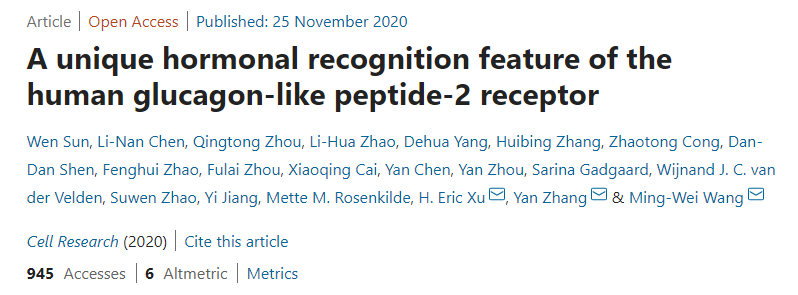
 Audited Supplier
Audited Supplier
In This Store
Glucagon-like peptides (GLP-1 and GLP-2) are glucagon-derived gut hormones that introduce different physiological functions through two related receptors (GLP-1R and GLP-2R), which are important drug targets for metabolic disorders and Crohn's disease, respectively.Despite tremendous progress in the measurement of GLP-1R structure, the understanding of the differences in peptide binding and signal orientation between these two receptors remains elusive.
Recently, a research paper published in CellRearch reported the cryo-electron microscopic structure of human GLP-2R and GLP-2 and GS heterotrimeric complexes.

To accommodate GLP-2 rather than GLP-1, GLP-2R will fine-tune the extracellular conformation of transmembrane helices (TMs) and extracellular loop 1 (ECL1).In contrast to GLP-1, the N-terminal amino acid of GLP-2 penetrates into the receptor nucleus in a unique direction.The intermediate region of GLP-2 binds more extensively to TM1 and TM7 than to ECL2. The GLP-2C terminus is closely related to ECL1, which is most prominent among the nine BG protein idol receptors (GPCRs).Functional studies have shown that the above three parts of GLP-2 are essential for the recognition and activation of GLP-2, especially in the intermediate region.These results provide new insights into the molecular basis of ligand specificity of grade B GPCRs and may facilitate the development of more specific therapies.
GLP-2R belongs to the class B GPCR subfamily and is mainly expressed in the intestine, pancreas and brain.Its endogenous ligands are GLP-2 of the glucagon-like peptide family, including GLP-1 and glucagon.GLP-2 is encoded by the pre-glucagon gene and processed into activity by pre-hormone convertase after translation.As a gastrointestinal hormone, it mainly regulates the growth and function of intestinal epithelial cells and is essential for nutrient absorption.Similar to GLP-1, GLP-2 is rapidly inactivated by dipeptidyl peptidase in vivo.
Clinically, GLP-2 analogues, teduglutide, are used to treat short bowel syndrome and Crohn's disease.Other therapeutic indications are currently being developed, including colitis, gastrointestinal disorders in children, and intestinal mucositis.According to the latest studies in animal models, GLP-2 plays an important role in glucose stability, spontaneous hypertension and depression, and renewed attention has been paid to the role of this peptide in the extragastrointestinal tract.
Cryo-electron microscopy (cryo-EM) is the main method to determine the structure of GPCR-G protein complexes, starting with GLP-1R and calcium-lowering receptors, followed by eight other class B GPCRs and various G protein complexes.These structures indicate that the B-level GPCR has a common activation mode, which is basically consistent with the binding mode of the two domains proposed previously.Class B objects have roughly the same pattern of activity, but the details of the molecule are object specific, especially in the binding region of the ligand.Therefore, exploring the recognition mechanism between GLP-2 and GLP-2R is of great significance for ligand recognition and acceptance activation mechanism between grade B GPCRs.
This study used cryo-EM to determine the high-resolution structure of human GLP-2R in complex with Gs proteins.Based on previous experience, the NanoBiT strategy was used to stabilize the GLP-2-GLP-2R-GS composite, enhance the interaction between GLP-2R and Gbeta, and form frozen EM structures in the overall range with a resolution of 3.0.The data from this study provide a reasonable template that could facilitate the design of better therapies for GLP-2 analogues and expand understanding of the family biology of this receptor.
For any requests of Peptide for research purpose, welcome to contact us. www.gtpeptide.com , sales1@gotopbio.com.

Contact Us
Tel: (+86) 400 610 1188
WhatsApp/Telegram/Wechat: +86 13621645194
+86 15021993094
Follow Us:




 Pharma Sources Insight July 2025
Pharma Sources Insight July 2025


